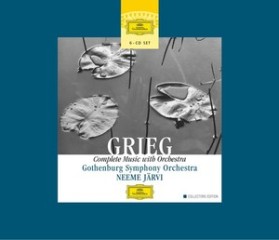Edvard Grieg - Complete Music with Orchestra CD4 (2001)
Edvard Grieg - Complete Music with Orchestra CD4 (2001)

Peer Gynt Op. 23 Incidental Music To The Play By Henrik Ibsen 4-1 No. 24 Nattscene 6:59 4-2 No. 25 Pinsesalme: »Velsignede Morgen« 1:15 4-3 No. 26 Solveigs Vuggevise 5:38 Sigurd Jorsalfar Op. 22 Incidental Music To The Play By Bjørnstjerne Bjørnson 35:12 4-4 Hornsignaler 1:49 4-5 No. 1 Forspill Til Akt I 2:16 4-6 No. 2 Borghild's Drøm 3:17 4-7 No. 3 Ved Mannjevningen 3:39 4-8 No. 4 Norrønafolket 6:10 4-9 No. 5 Hyldningsmarsj 8:48 4-10 No. 6 Mellomspill I 1:40 4-11 No. 7 Mellomspill II 3:45 4-12 No. 8 Kongekvadet 3:48 - 4-13 Funeral Music In Memory Of Rikard Nordraak 6:41 Norwegian Dances Op. 35 17:10 4-14 1. Allegro Marcato 6:08 4-15 2. Allegretto Tranquillo E Grazioso 2:30 4-16 3. Allegro Moderato Alla Marcia 3:16 4-17 4. Allegro Molto 5:16 Barbara Bonney – soprano Maria Andersson - soprano Monica Einarson – soprano Marianne Eklöf – mezzo-soprano Carl Gustaf Holmgren - baritone Urban Malmberg – baritone Pro Musica Chamber Choir Malcolm Page,Per Göran, Sören Hermans, Vivika Alm - horns Gothenburg Symphony Orchestra Neeme Järvi – conductor
Sigurd Jorsalfar is also claimed to be the first recording of the authentic version and in this case, too, it was preceded by a "complete" Unicorn version under Per Dreier which I haven’t heard, so I can’t say what the differences are. Sigurd is a tale of romantic chivalry and draws from Grieg music of a certain heroic dignity, mostly diatonic and brassy. There is no revelation here comparable to that of Peer Gynt. There are no melodramas or fragments, apart from the opening horn calls which are simply arpeggios that anybody could write. In addition to the usual three orchestral pieces (also here you get instructions for programming just these) there are two rousing ballad-style numbers for tenor and chorus. These are well worth hearing, and the Act 1 Prelude, based on the same theme as the final chorus, gives a certain symmetry to the sequence. But the first Interlude is mostly, and the second wholly, based on the Homage March, in itself not exactly unrepetitive. This may have a point in the theatre but when the pieces follow each other consecutively it seems pious completism to hear it three times over.
The tenor has an attractive if sometimes tremulous timbre and the male voices are rough on their top A (it only happens once) but the orchestra is splendid and Järvi sees that the spirit is always right.
The Funeral March for Rikard Nordraak is not thematically memorable but it is a striking expression not only of numbed grief but also of protest at the death at a mere 23 years of a friend in whom Grieg had such high hopes. Emphatically more than a pièce d’occasion.
The Norwegian Dances were written for piano duet and orchestrated by Hans Sitt. Since these orchestrations were made after Grieg’s death (the German booklet note tells us this, the English one does not) they do not have the semi-authority of Seidl’s arrangements in the Lyric Suite, which Grieg saw and revised. That being so, arguably they have no place here. The puzzling thing is that (as I have pointed out above) the first three dances were included in a Copenhagen revival of Peer Gynt in 1886, and so orchestrations must have been made or at least approved by Grieg for that occasion. Do they still exist?
However, Sitt did a very expert job. These pieces are less pretentious than the Symphonic Dances, but I feel their place is in the domestic hearth envisaged by their original version. Though the music is very charming it lacks development, something which is emphasised by hearing it on a full scale orchestra. One feels, as one does not with the Dvorak Slavonic Dances or even the Brahms Hungarian Dances, most of which were not orchestrated by Brahms himself, that a sledge-hammer is being used to crack a nut. Lively performances from Järvi but perhaps for once he tries to read too much into the slower sections at times. ---Christopher Howell, musicweb-international.com
download (mp3 @320 kbs):
yandex 4shared mega mediafire uloz.to cloudmailru gett








